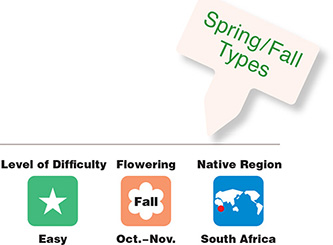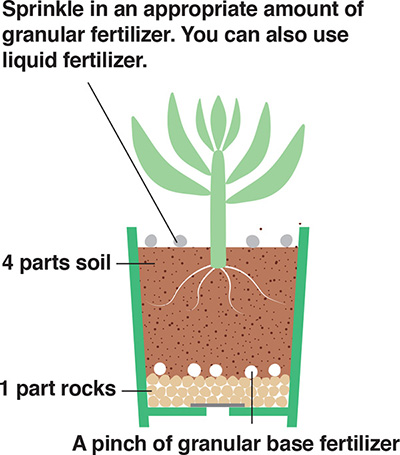Spring/Fall Types
Crassula capitella “Campfire”

Characteristics of Campfire
The leaves of this species change color in the cold, dyed a beautiful scarlet as if consumed by flames. It is during this time that the plant is truly worthy of the name “Campfire.” Otherwise, the leaves are bright green. These easy-to-grow succulents undergo rapid growth during the growing seasons of spring and fall, and beginning around the end of summer, their stems will stretch up tall and produce little white flowers. These plants originated in South Africa and grow to about 6 inches (15 cm) tall.

Points to Check when Buying
Avoid buying etiolated seedlings that are too tall and have too much space between the leaves, or that are a pale, yellow-green color around the leaves.

Soil Composition
Mix 5 parts small-grain Akadama, 3 parts Kanuma soil, and 2 parts mulch for a ratio that has good drainage, water retention, and breathability. Add a layer of gravel like large-grain Akadama or pumice to the bottom of the pot.

Fertilizer
When you transplant a succulent, add a layer of granular base fertilizer on top of the layer of gravel.
How to Transplant
Move the succulent from its container to soil. When you pull out the plant, check its roots and remove any darkened or damaged ones before transplanting to the new soil.

Pour in the slightly dampened new soil. When you have finished transplanting, lightly tap the pot to level the soil and place the plant in partial shade to take root.
How to Propagate
You can propagate from a leaf cutting, or cut off a side branch with leaves attached, let the cut end dry for a few days, and insert it into soil. Slightly dampened soil will encourage the plant to take root.
Leaf Cutting

Place the leaf you removed from the succulent stem on the surface of dampened soil, and after about 10 days the leaf will begin to take root and sprout. When your new plant has grown 4 or 5 leaves, pull it from the soil, taking care not to injure the roots, and transplant it.
Stem Cutting

Let the cut end of the branch dry out for 4–5 days, and then insert the branch into soil. During the first half month until the plant takes root, keep the soil constantly damp and leave the plant in partial shade. After the plant has taken root, you can care for it as usual.
Key Points for Growing Campfire
Campfire is robust and easy to grow, like Jade Plant, another member of the Crassula genus. It can also tolerate rain. Its growth seasons are spring and fall, and you should grow a Campfire succulent in a sunny location. Give your plant lots of water when the top soil dries out. Your plant will manage to survive midsummer one way or another. When fall arrives, it will resume its rapid growth, but when the weather turns cold its growth will slow again and you will need to water it less frequently. Take your succulent inside on nights when the temperature drops below freezing.
Cultivation Calendar

Succulent Advice Q&A
Q Why won’t my succulent’s leaves turn red, even in the cold?
A Normally, a succulent will take in a lot of sunlight during the fall, and then turn red when a cold spell comes along. However, if you have been growing the plant in the shade or indoors, it may not turn red because of a lack of sunlight. If the plant is etiolated, it is suffering from a lack of sunlight. Also, the leaves will change from red back to their green color in spring, but this is just proof that the plant is active in its growing period and is not a problem.


As the weather grows colder, Campfire becomes a fiery red.
Members of the Crassula Genus

C. cordata

C. sarmentosa

C. alba

C. fusca

C. ovata “Variegated Jade Plant”

C. “Morgan’s Beauty”